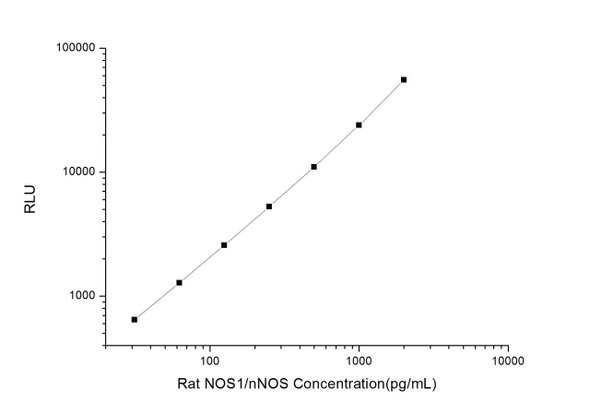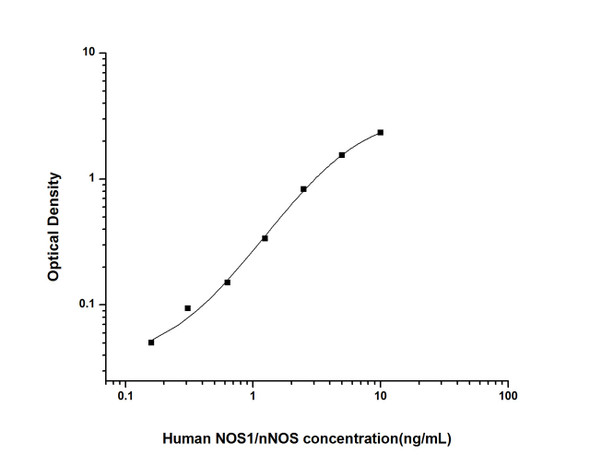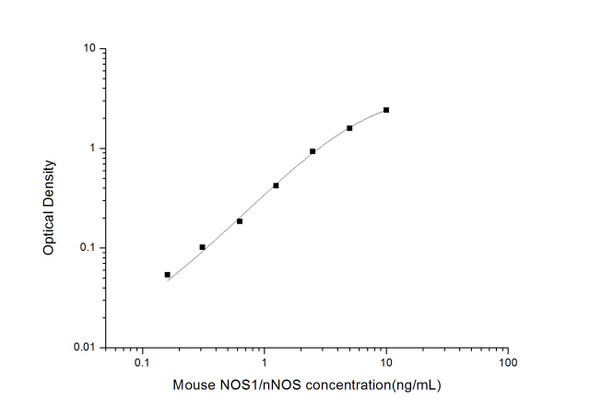Human Cell Biology ELISA Kits 3
Human NOS1/nNOS (Nitric Oxide Synthase 1, Neuronal) CLIA Kit (HUES00468)
- SKU:
- HUES00468
- Product Type:
- ELISA Kit
- ELISA Type:
- CLIA Kit
- Size:
- 96 Assays
- Sensitivity:
- 18.75pg/mL
- Range:
- 31.25-2000pg/mL
- ELISA Type:
- Sandwich
- Synonyms:
- bNOS, IHPS1
- Reactivity:
- Human
- Sample Type:
- Serum, plasma and other biological fluids
- Research Area:
- Cell Biology
Description
| Assay type: | Sandwich |
| Format: | 96T |
| Assay time: | 4.5h |
| Reactivity: | Human |
| Detection method: | Chemiluminescence |
| Detection range: | 31.25-2000 pg/mL |
| Sensitivity: | 18.75 pg/mL |
| Sample volume: | 100µL |
| Sample type: | Serum, plasma and other biological fluids |
| Repeatability: | CV < 15% |
| Specificity: | This kit recognizes Human NOS1/nNOS in samples. No significant cross-reactivity or interference between Human NOS1/nNOS and analogues was observed. |
This kit uses Sandwich-CLIA as the method. The micro CLIA plate provided in this kit has been pre-coated with an antibody specific to Human NOS1/nNOS. Standards or samples are added to the appropriate micro CLIA plate wells and combined with the specific antibody. Then a biotinylated detection antibody specific for Human NOS1/nNOS and Avidin-Horseradish Peroxidase (HRP) conjugate are added to each micro plate well successively and incubated. Free components are washed away. The substrate solution is added to each well. Only those wells that contain Human NOS1/nNOS, biotinylated detection antibody and Avidin-HRP conjugate will appear fluorescence. The Relative light unit (RLU) value is measured spectrophotometrically by the Chemiluminescence immunoassay analyzer. The RLU value is positively associated with the concentration of Human NOS1/nNOS. The concentration of Human NOS1/nNOS in the samples can be calculated by comparing the RLU of the samples to the standard curve.
| UniProt Protein Function: | nNOS: nitric oxide synthase 1, neuronal form. Produces nitric oxide which is a messenger molecule with diverse functions and displays many properties of a neurotransmitter in the brain and peripheral nervous system. May be an effector enzyme for the dystrophin complex. Four alternatively spliced isoforms have been described. |
| UniProt Protein Details: | Protein type:Amino Acid Metabolism - arginine and proline; EC 1. 14. 13. 39; Oxidoreductase Chromosomal Location of Human Ortholog: 12q24. 22 Cellular Component: cytoplasm; cytoskeleton; cytosol; lipid raft; mitochondrion; nucleoplasm; perinuclear region of cytoplasm; photoreceptor inner segment; plasma membrane; protein complex; sarcolemma; sarcoplasmic reticulum; synapse Molecular Function:cadmium ion binding; FAD binding; FMN binding; heme binding; NADP binding; NADPH-hemoprotein reductase activity; nitric-oxide synthase activity; protein binding; sodium channel regulator activity Biological Process: arginine catabolic process; cell redox homeostasis; exogenous drug catabolic process; multicellular organismal response to stress; myoblast fusion; negative regulation of blood pressure; negative regulation of calcium ion transport; negative regulation of hydrolase activity; negative regulation of potassium ion transport; negative regulation of serotonin uptake; neurotransmitter biosynthetic process; nitric oxide biosynthetic process; nitric oxide mediated signal transduction; peptidyl-cysteine S-nitrosylation; positive regulation of guanylate cyclase activity; positive regulation of histone acetylation; positive regulation of transcription from RNA polymerase II promoter; positive regulation of transcription, DNA-dependent; regulation of sodium ion transport; response to heat; response to hypoxia; striated muscle contraction; vasodilation Disease: Pyloric Stenosis, Infantile Hypertrophic, 1 |
| NCBI Summary: | The protein encoded by this gene belongs to the family of nitric oxide synthases, which synthesize nitric oxide from L-arginine. Nitric oxide is a reactive free radical, which acts as a biologic mediator in several processes, including neurotransmission, and antimicrobial and antitumoral activities. In the brain and peripheral nervous system, nitric oxide displays many properties of a neurotransmitter, and has been implicated in neurotoxicity associated with stroke and neurodegenerative diseases, neural regulation of smooth muscle, including peristalsis, and penile erection. This protein is ubiquitously expressed, with high level of expression in skeletal muscle. Multiple transcript variants that differ in the 5' UTR have been described for this gene but the full-length nature of these transcripts is not known. Additionally, alternatively spliced transcript variants encoding different isoforms (some testis-specific) have been found for this gene. [provided by RefSeq, Feb 2011] |
| UniProt Code: | P29475 |
| NCBI GenInfo Identifier: | 1709333 |
| NCBI Gene ID: | 4842 |
| NCBI Accession: | P29475. 2 |
| UniProt Secondary Accession: | P29475,O75713, E9PH30, |
| UniProt Related Accession: | P29475 |
| Molecular Weight: | 161kDa |
| NCBI Full Name: | Nitric oxide synthase, brain |
| NCBI Synonym Full Names: | nitric oxide synthase 1 |
| NCBI Official Symbol: | NOS1 |
| NCBI Official Synonym Symbols: | NOS; bNOS; nNOS; IHPS1; N-NOS; NC-NOS |
| NCBI Protein Information: | nitric oxide synthase, brain |
| UniProt Protein Name: | Nitric oxide synthase, brain |
| UniProt Synonym Protein Names: | Constitutive NOS; NC-NOS; NOS type I; Neuronal NOS; N-NOS; nNOS; Peptidyl-cysteine S-nitrosylase NOS1; bNOS |
| Protein Family: | Nitric oxide synthase |
| UniProt Gene Name: | NOS1 |
As the RLU values of the standard curve may vary according to the conditions of the actual assay performance (e. g. operator, pipetting technique, washing technique or temperature effects), the operator should establish a standard curve for each test. Typical standard curve and data is provided below for reference only.
| Concentration (pg/mL) | RLU | Average | Corrected |
| 2000 | 51108 60334 | 55721 | 55693 |
| 1000 | 23725 24223 | 23974 | 23946 |
| 500 | 11185 10879 | 11032 | 11004 |
| 250 | 5098 5490 | 5294 | 5266 |
| 125 | 2629 2587 | 2608 | 2580 |
| 62.5 | 1347 1275 | 1311 | 1283 |
| 31.25 | 650 698 | 674 | 646 |
| 0 | 27 29 | 28 | -- |
Precision
Intra-assay Precision (Precision within an assay): 3 samples with low, mid range and high level Human NOS1/nNOS were tested 20 times on one plate, respectively.
Inter-assay Precision (Precision between assays): 3 samples with low, mid range and high level Human NOS1/nNOS were tested on 3 different plates, 20 replicates in each plate.
| Intra-assay Precision | Inter-assay Precision | |||||
| Sample | 1 | 2 | 3 | 1 | 2 | 3 |
| n | 20 | 20 | 20 | 20 | 20 | 20 |
| Mean (pg/mL) | 91.67 | 303.12 | 894.45 | 83.50 | 310.25 | 808.92 |
| Standard deviation | 9.56 | 25.73 | 62.16 | 9.83 | 33.94 | 62.45 |
| C V (%) | 10.43 | 8.49 | 6.95 | 11.77 | 10.94 | 7.72 |
Recovery
The recovery of Human NOS1/nNOS spiked at three different levels in samples throughout the range of the assay was evaluated in various matrices.
| Sample Type | Range (%) | Average Recovery (%) |
| Serum (n=5) | 90-104 | 96 |
| EDTA plasma (n=5) | 95-106 | 101 |
| Cell culture media (n=5) | 83-98 | 90 |
Linearity
Samples were spiked with high concentrations of Human NOS1/nNOS and diluted with Reference Standard & Sample Diluent to produce samples with values within the range of the assay.
| Serum (n=5) | EDTA plasma (n=5) | Cell culture media (n=5) | ||
| 1:2 | Range (%) | 96-109 | 99-110 | 88-100 |
| Average (%) | 103 | 104 | 93 | |
| 1:4 | Range (%) | 98-114 | 91-106 | 97-110 |
| Average (%) | 105 | 99 | 104 | |
| 1:8 | Range (%) | 88-100 | 97-110 | 101-115 |
| Average (%) | 94 | 104 | 107 | |
| 1:16 | Range (%) | 96-113 | 98-115 | 89-104 |
| Average (%) | 103 | 105 | 96 |
An unopened kit can be stored at 4°C for 1 month. If the kit is not used within 1 month, store the items separately according to the following conditions once the kit is received.
| Item | Specifications | Storage |
| Micro CLIA Plate(Dismountable) | 8 wells ×12 strips | -20°C, 6 months |
| Reference Standard | 2 vials | |
| Concentrated Biotinylated Detection Ab (100×) | 1 vial, 120 µL | |
| Concentrated HRP Conjugate (100×) | 1 vial, 120 µL | -20°C(shading light), 6 months |
| Reference Standard & Sample Diluent | 1 vial, 20 mL | 4°C, 6 months |
| Biotinylated Detection Ab Diluent | 1 vial, 14 mL | |
| HRP Conjugate Diluent | 1 vial, 14 mL | |
| Concentrated Wash Buffer (25×) | 1 vial, 30 mL | |
| Substrate Reagent A | 1 vial, 5 mL | 4°C (shading light) |
| Substrate Reagent B | 1 vial, 5 mL | 4°C (shading light) |
| Plate Sealer | 5 pieces | |
| Product Description | 1 copy | |
| Certificate of Analysis | 1 copy |
- Set standard, test sample and control (zero) wells on the pre-coated plate and record theirpositions. It is recommended to measure each standard and sample in duplicate. Note: addall solutions to the bottom of the plate wells while avoiding contact with the well walls. Ensuresolutions do not foam when adding to the wells.
- Aliquot 100µl of standard solutions into the standard wells.
- Add 100µl of Sample / Standard dilution buffer into the control (zero) well.
- Add 100µl of properly diluted sample (serum, plasma, tissue homogenates and otherbiological fluids. ) into test sample wells.
- Cover the plate with the sealer provided in the kit and incubate for 90 min at 37°C.
- Aspirate the liquid from each well, do not wash. Immediately add 100µL of BiotinylatedDetection Ab working solution to each well. Cover the plate with a plate seal and gently mix. Incubate for 1 hour at 37°C.
- Aspirate or decant the solution from the plate and add 350µL of wash buffer to each welland incubate for 1-2 minutes at room temperature. Aspirate the solution from each well andclap the plate on absorbent filter paper to dry. Repeat this process 3 times. Note: a microplatewasher can be used in this step and other wash steps.
- Add 100µL of HRP Conjugate working solution to each well. Cover with a plate seal andincubate for 30 min at 37°C.
- Aspirate or decant the solution from each well. Repeat the wash process for five times asconducted in step 7.
- Add 100µL of Substrate mixture solution to each well. Cover with a new plate seal andincubate for no more than 5 min at 37°C. Protect the plate from light.
- Determine the RLU value of each well immediately.






